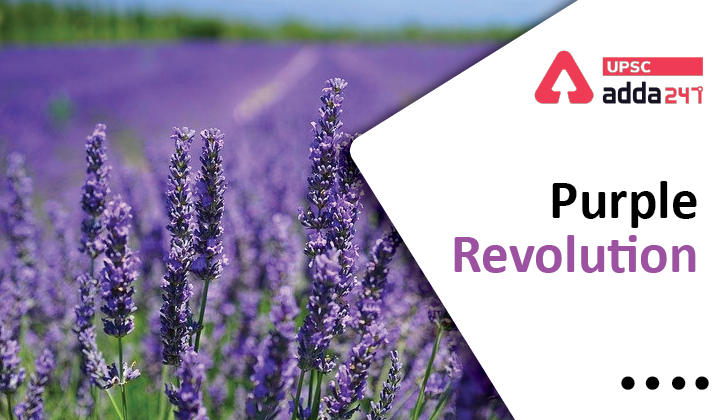Table of Contents
Purple Revolution and Aroma Mission: Relevance
The Purple Revolution in the Indian state of Jammu and Kashmir refers to the growth of lavender cultivation, supported by the government initiative called the Aroma Mission. This initiative, launched in 2016, aims to promote the cultivation of lavender and other aromatic crops in the region. The Purple Revolution has brought several benefits to the area, including improved economic conditions for farmers, as lavender is a high-value crop that has doubled their incomes. Additionally, it has created new employment opportunities in the agriculture, manufacturing, and tourism sectors due to the increasing demand for lavender products.
Moreover, the Purple Revolution has contributed to the development of a sustainable economy in the region, as lavender is a drought-tolerant crop that does not require the use of harmful chemicals. The Aroma Mission has extended its influence beyond Jammu and Kashmir, promoting aromatic crop cultivation across India, providing training and financial assistance to farmers, and creating a market for these crops.
Furthermore, it is working with businesses to develop new products from aromatic crops, both for domestic and international markets and collaborating with traditional healers to explore the medicinal properties of these crops. Overall, the Purple Revolution and the Aroma Mission are significant initiatives that have improved the economic, environmental, and social conditions in India by creating opportunities and promoting sustainability. Here are some of the benefits of the Purple Revolution and the Aroma Mission:
- Economic benefits: The Purple Revolution and the Aroma Mission have helped to improve the economic conditions of farmers in the region. Lavender is a high-value crop, and its cultivation has helped to double the incomes of many farmers.
- Environmental benefits: Lavender is a drought-tolerant crop, and its cultivation does not require the use of pesticides or herbicides. This makes lavender a sustainable crop that can help to protect the environment.
- Social benefits: The Purple Revolution and the Aroma Mission have helped to create new jobs in the region. There is a growing demand for lavender products, and the cultivation of lavender has created new opportunities for employment in the agricultural sector, the manufacturing sector, and the tourism sector.
Purple Revolution and Aroma Mission: Context
- Recently, the Union Minister of Personnel, Public Grievances & Pensions the chaired the District Development Coordination & Monitoring Committee (DISHA) meetings of districts Doda and Kishtwar, and has informed that Lavender has been designated as Doda brand product.
Purple Revolution and Aroma Mission: Key points
- Doda is the birthplace of India’s Purple Revolution (Aroma Mission) and lavender can be promoted under the ‘One District, One Product’ initiative to attract Agri- StartUps, entrepreneurs, and farmers.
- Rattle Project, which will along with the Pakkal-Dul project and Kiru project make the entire region Power-surplus, has been revived to achieve its full potential.
Aroma Mission
- CSIR-IIIM’s Aroma Mission is providing means of livelihood to budding farmers and Agri-Technocrats and promoting the spirit of entrepreneurship giving a boost to the Start-Up India campaign.
- Regarding the purple revolution, awareness programs should be organized to showcase the lucrative aspects of lavender cultivation so that start-ups under Aroma Mission would be encouraged.
- This would also enhance the image of Doda District which is the birthplace of Purple Revolution.
Purple Revolution in India
- “Purple Revolution” is Jammu & Kashmir’s contribution to “Start-ups India.
- It is also called an aroma mission and was launched by the Union Ministry of Science & Technology through the Council of Scientific & Industrial Research (CSIR).
- CSIR had introduced high-value essential oil-bearing lavender crops through its Jammu-based laboratory, the Indian Institute of Integrative Medicines (IIIM) for cultivation in districts Doda, Kishtwar, and Rajouri, among others.
- In a brief span of time, aroma/lavender cultivation has become a popular option in farming for agricultural start-ups.
Aroma Mission Phase-1
- During Phase-I of the Aroma Mission, CSIR helped cultivate 6000 hectares of land and covered 46 aspirational districts across the country.
- More than 44,000 persons have been trained and several crores of farmers’ revenue were generated in the first phase. Major crop-cropping patterns in various parts of the country.
Aroma Mission Phase-2
- CSIR has launched Phase II of the Aroma Mission after the completion of Phase-I.
- In addition to IIIM, several other CSIR institutes are also now participating in the Aroma Mission.
- In the second Phase of the Aroma Mission, it is proposed to engage over 45,000 skilled human resources with the aim of benefitting more than 75,000 farming families across the country.



 TSPSC Group 1 Question Paper 2024, Downl...
TSPSC Group 1 Question Paper 2024, Downl...
 TSPSC Group 1 Answer key 2024 Out, Downl...
TSPSC Group 1 Answer key 2024 Out, Downl...
 UPSC Prelims 2024 Question Paper, Downlo...
UPSC Prelims 2024 Question Paper, Downlo...




